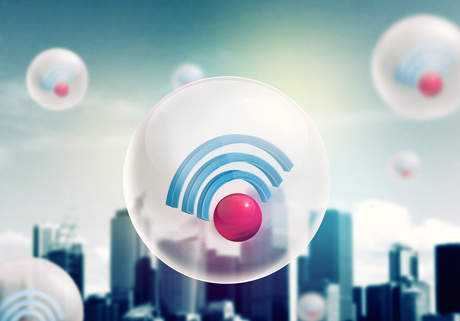Top intelligent building trends

On average, people spend around 20 hours each day inside residential or commercial buildings, according to The Royal Institute of British Architects. As the world’s population continues to expand beyond the current seven-and-a-half billion people, so will the number of buildings in which we live and work. Intelligent buildings can improve efficiency, cut costs and help attract and retain tenants and staff.
The Internet of Things (IoT), sensors networks, Category 6A and fibre technologies were hot topics in 2015, particularly in the building industry. Below is a summary of key trends that will influence intelligent buildings in 2016.
Seamless connectivity
With the number of active mobile connections (GSMA Intelligence) globally now exceeding the the world population, and with the vast majority of mobile connections originating or terminating within a building, it is indisputable that people expect to be able to perform much of their normal business via cellular or Wi-Fi based wireless connections. This need is driving network design to cover: using Wi-Fi technology and supporting network infrastructure based on the latest standards (IEEE standard 802.11ac (wave 2)); deploying dedicated in-building wireless technology through distributed antenna systems or small cell solutions to optimise cellular coverage across the workplace.
Connectivity in buildings should be thought of in the same way as any basic utility like water and gas; this means the IoT infrastructure must be planned and designed at the building design stage.
Power
Power loads in commercial buildings are increasing, primarily due to the proliferation of active field devices such as: wireless access points and in-building wireless antennas; IP network cameras and VoIP phones; LED light and environmental controllers. Understanding how to power these devices efficiently and effectively in a building is a growing challenge. Traditionally, the power supplied to buildings has been alternating current (AC) power, which is then stepped down or converted to direct current (DC) using transformers/rectifiers in order to power devices inside buildings. However, with governments demanding that carbon dioxide emissions associated with buildings be minimised, attention has now turned to improving the efficiency of low-voltage power distribution networks inside buildings.
In most instances, active devices in buildings are Internet Protocol (IP)-enabled devices driven by the need for convergence. For these devices, power can be provided via low (or extra low) voltage direct current (DC). For decades, Ethernet cabling deployed for data network connectivity in buildings has also provided DC power. This approach has the benefit of being standards based. IEEE Power over Ethernet (PoE) 802.3af and IEEE Power over Ethernet Plus (PoEP) 802.3at are the current standards. An IEEE taskforce is now discussing the next evolution of the PoE standard (IEEE 802.3bt) with a stated aim of 49 W minimum power levels and a likely maximum of 100 W. Power over HDBase-T (PoH) is another approach developed by an alliance of consumer electronics manufacturers that offers a maximum power level of 100 W. As DC power levels continue to increase, different IP devices will emerge, driving the need for even more efficient low-voltage DC power in buildings.
Improving the employee/tenant experience
In a globally competitive world, businesses need to offer ‘best in class’ work spaces that positively influence health/wellness and productivity in order to attract employees and tenants. To improve an environment, it’s important to measure environmental, space and energy metrics. Embedding increasingly sophisticated sensor technology into the fabric of a building enables this data to be instantly collected, processed and acted on. This approach offers the following benefits: capability to automatically and efficiently manage shared spaces; management of ambient room/building conditions, including light level, temperature and humidity; ability to help minimise a building’s carbon footprint by real-time energy optimisation, reducing operating costs and also improving corporate social responsibility indices. Integrated Workplace Management Systems (IWMS) and other software platforms will feed off this type of data to help create a better workplace.
Integrating devices on a common network infrastructure
The Internet of Things (IoT) is a tangible phenomenon. The reduction in costs, sensor miniaturisation, plus advances in device connectivity capability have led to a rapid proliferation of connected devices in commercial buildings. However, as the number of connected devices increases, so do the challenges. A few years ago, commercial buildings used multiple, proprietary subsystems for their various management systems. The dominance of IP networking and associated global standards (like IEEE 802.3) across almost all aspects of technology has allowed all building management systems and associated devices to be interconnected through common wired or wireless infrastructure.
There is a myriad of connected devices, but are they communicating? The lack of a generally accepted protocol for device-to-device communication leads to inefficiencies. This communication ‘failure’ means that buildings are ‘dumber’ than they should be. Interoperability standards are progressing with the AllSeen Alliance and the Industrial Internet Consortium being two of the larger groups working on standard development. Devices that speak the same language and use the same network infrastructure can aggregate and process real-time data about their immediate environment in a highly efficient way.
In 2016, organisations will tackle the challenge of not just gathering the data, but analysing it and using it to improve building efficiencies and workplace productivity.
How smart HVAC is creating sustainable buildings
By integrating advanced technology and data-driven strategies, building operators can greatly...
Smelly research could influence HVAC industry
In a dedicated lab space that mimics a tiny house, scientists are investigating the impact of...
Lifestyle community gains a new level of connectivity
GemLife, a developer of over-50s lifestyle communities, was facing challenges with its fixed...




